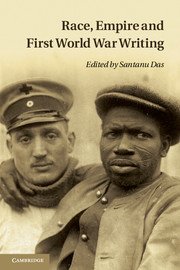Book contents
- Frontmatter
- Contents
- List of illustrations
- Acknowledgements
- Notes on contributors
- Introduction
- PART I VOICES AND EXPERIENCES
- 1 ‘An army of workers’: Chinese indentured labour in First World War France
- 2 Sacrifices, sex, race: Vietnamese experiences in the First World War
- 3 Indians at home, Mesopotamia and France, 1914–1918: towards an intimate history
- 4 ‘We don't want to die for nothing’: askari at war in German East Africa, 1914–1918
- 5 France's legacy to Demba Mboup? A Senegalese griot and his descendants remember his military service during the First World War
- PART II PERCEPTIONS AND PROXIMITIES
- PART III NATIONALISM, MEMORY AND LITERATURE
- Index
- References
3 - Indians at home, Mesopotamia and France, 1914–1918: towards an intimate history
Published online by Cambridge University Press: 05 February 2014
- Frontmatter
- Contents
- List of illustrations
- Acknowledgements
- Notes on contributors
- Introduction
- PART I VOICES AND EXPERIENCES
- 1 ‘An army of workers’: Chinese indentured labour in First World War France
- 2 Sacrifices, sex, race: Vietnamese experiences in the First World War
- 3 Indians at home, Mesopotamia and France, 1914–1918: towards an intimate history
- 4 ‘We don't want to die for nothing’: askari at war in German East Africa, 1914–1918
- 5 France's legacy to Demba Mboup? A Senegalese griot and his descendants remember his military service during the First World War
- PART II PERCEPTIONS AND PROXIMITIES
- PART III NATIONALISM, MEMORY AND LITERATURE
- Index
- References
Summary
At the heart of Delhi stands the India Gate, a majestic 42-metre-high colonial arch, dedicated to the ‘dead of the Indian armies who fell honoured in France and Flanders, Mesopotamia and Persia, East Africa, Gallipoli and Elsewhere in the Near and the Far East in the 1914–1918 war’ and to those killed in the North-West Frontier operations and the Afghan War of 1919. India made the largest contribution to the First World War in terms of manpower of any of the colonies or dominions of the British empire. According to government records of the time, the total number of Indian ranks recruited during the war up to 31 December 1919 was 877,068 combatants and 563,369 non-combatants, making a total of 1,440,437; in addition, there were an estimated 239,561 men in the British Indian army in 1914. Yet in metropolitan middle-class memory in India (except in the Punjab), there is often a strange gap about the Indian experience of the First World War. Coming largely from the semiliterate, peasant-warrior classes of northern India, these men and their stories have been doubly marginalised: they have mostly been ignored in Indian nationalist-elitist historiography as well as in the modern European memory of the First World War.
- Type
- Chapter
- Information
- Race, Empire and First World War Writing , pp. 70 - 89Publisher: Cambridge University PressPrint publication year: 2011
References
- 3
- Cited by

